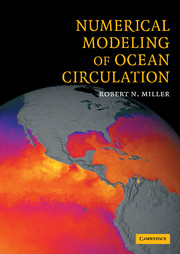6 - Models of the coastal ocean
Published online by Cambridge University Press: 19 February 2010
Summary
Introduction
In recent years interest in the coastal ocean has increased throughout the world scientific community. Knowledge of the coastal oceans is directly relevant to issues of resource management and security, among others, and is therefore of broad societal interest, since a large proportion of the world's population lives near coastlines. In a purely scientific context, new instruments such as surface velocity mapping radars have been developed, and advances in computers and computing techniques have made detailed models of the coastal ocean practical.
The essential physical mechanisms that determine the most interesting aspects of coastal flow differ from season to season and from location to location. Coastal flows are affected by tides. Nonlinear effects can include rectification, so periodic tidal forcing of the coastal ocean can lead to significant residual steady flows. Interaction of the barotropic tide with topography can result in significant baroclinic motion. Interaction with motions on longer timescales can be nontrivial, and simply averaging over tidal periods or implementing other strategies for filtering out the relatively high frequency tidal motions may not be sufficient to deal with tidal interactions. River outflow, with its associated buoyancy fluxes, can be important.
Coastal upwelling, with its ecological implications, is an important feature of coastal circulation in many areas, as are the coastal jet and the ubiquitous coastally trapped waves, which propagate with the coast on their right as you face in the direction of propagation in the northern hemisphere (see Exercises 6.2 and 6.3).
Surface and bottom boundary layers are of the order of tens of meters thick, and often contain many of the phenomena of interest, beyond simple vertical transfer of momentum and heat.
- Type
- Chapter
- Information
- Numerical Modeling of Ocean Circulation , pp. 175 - 198Publisher: Cambridge University PressPrint publication year: 2007



